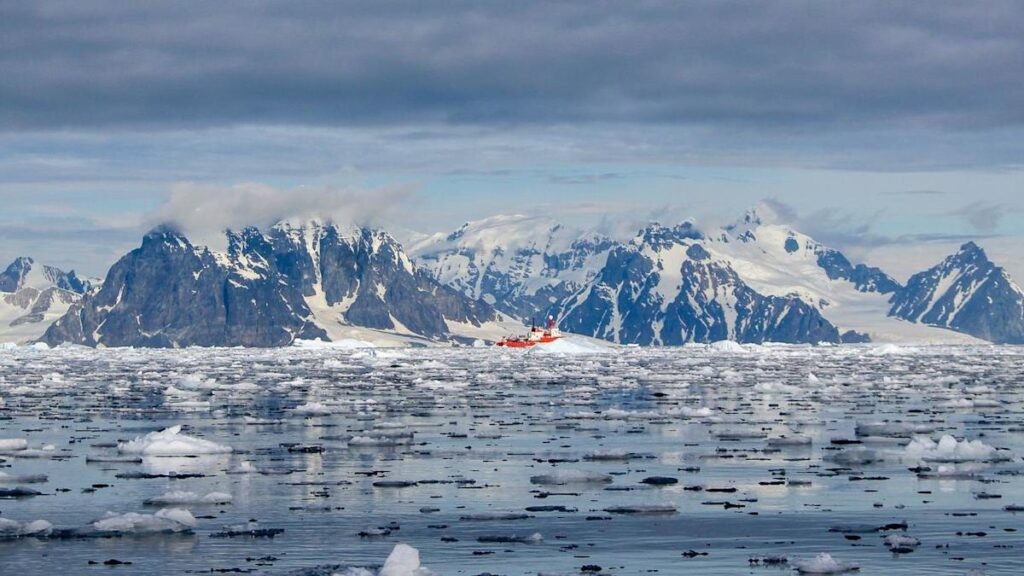
Braving the hand-numbing cold, icy winds, and rough seas of the Antarctic Peninsula, an international team of researchers embarked on a daring mission earlier this year. Their goal: to extract long tubes of mud from the seabed, potentially unlocking centuries of scientific secrets about the Southern Ocean. This effort aims to shed light on how human activities, including a century of industrial whaling, have impacted Antarctica and the planet at large.
The research is part of a global initiative to understand the intricate relationship between the ocean and climate. Scientists worldwide are now set to share and analyze these precious mud samples, hoping to uncover the historical interplay between marine ecosystems and human influence.
Unveiling a History of Ocean Life
Using a specialized coring drill, akin to a massive apple-corer, researchers drilled at depths of up to 500 meters, collecting over 40 long cores of seafloor sediment from various locations around the peninsula. This region, one of the richest habitats for marine life in Antarctica, has long been a focal point for fishing, tourism, and, until its ban in the 1980s, industrial whale hunting.
Lead researcher Dr. Elisenda Balleste from the University of Barcelona likened the sediment layers to a “book of history,” offering insights into past and present marine life and evidence of human impact. By preserving, dating, and analyzing these layers, scientists can reconstruct the history of Antarctic marine life.
Once aboard the research vessel, the cores were frozen and transported to Dr. Balleste’s laboratory in Barcelona. From there, pieces of this Antarctic mud will be distributed to academic institutions worldwide. Scientists will scan and date the sediment layers, identify microbial life forms, measure pollution levels, and calculate the carbon content buried within the mud.
The Convex Seascape Survey: A Global Collaboration
The project, known as the Convex Seascape Survey, involves universities and research institutions globally working together to better understand the ocean-climate connection. Claire Allen, an oceanographer from the British Antarctic Survey, emphasized the value of these sediment cores.
“Before 1950, before any monitoring capacity in Antarctica, sediment cores and ice cores are the only way to gain insight into climatic or physical changes over time,” she explained.
Onboard the ship, scientists carefully sliced the sediment cores for further analysis. These samples are crucial for reconstructing environmental conditions before modern monitoring began.
DNA Fingerprinting and the Legacy of Whaling
Some of the newly collected samples are earmarked for DNA analysis, requiring storage at temperatures low enough to halt biological processes. Dr. Balleste briefly displayed these samples, stored at minus 80 degrees Celsius, to ensure their preservation.
This environmental DNA analysis, a rapidly developing scientific field, allows researchers to extract genetic information from environmental samples, providing a “fingerprint” of life left behind. Dr. Carlos Preckler from King Abdullah University in Saudi Arabia leads this aspect of the research, focusing on the impact of nearly a century of industrial whaling on the ocean and atmosphere.
“We know whales contain significant carbon because they are huge animals,” Dr. Preckler noted. “Our aim is to measure how much of that carbon is sequestered in the seafloor when these animals die.”
By analyzing whale DNA and carbon levels in the sediment, researchers can assess the pre-whaling state of the Southern Ocean. This understanding will highlight how whales, by simply existing, contribute to carbon sequestration and aid in combating climate change.
Looking Ahead: Implications for Climate Science
The insights gained from these sediment cores could have far-reaching implications for climate science. As the world grapples with reducing carbon emissions, understanding natural processes that lock away carbon is vital. The research underscores the importance of marine life in regulating our planet’s climate.
Moving forward, the collaborative efforts of scientists worldwide will continue to unravel the complex history of Antarctica’s marine ecosystems. This knowledge not only enriches our understanding of past environmental changes but also informs future conservation and climate strategies.
As researchers delve deeper into the layers of Antarctic mud, they hope to uncover more secrets about the ocean’s past and its role in shaping our planet’s future.







